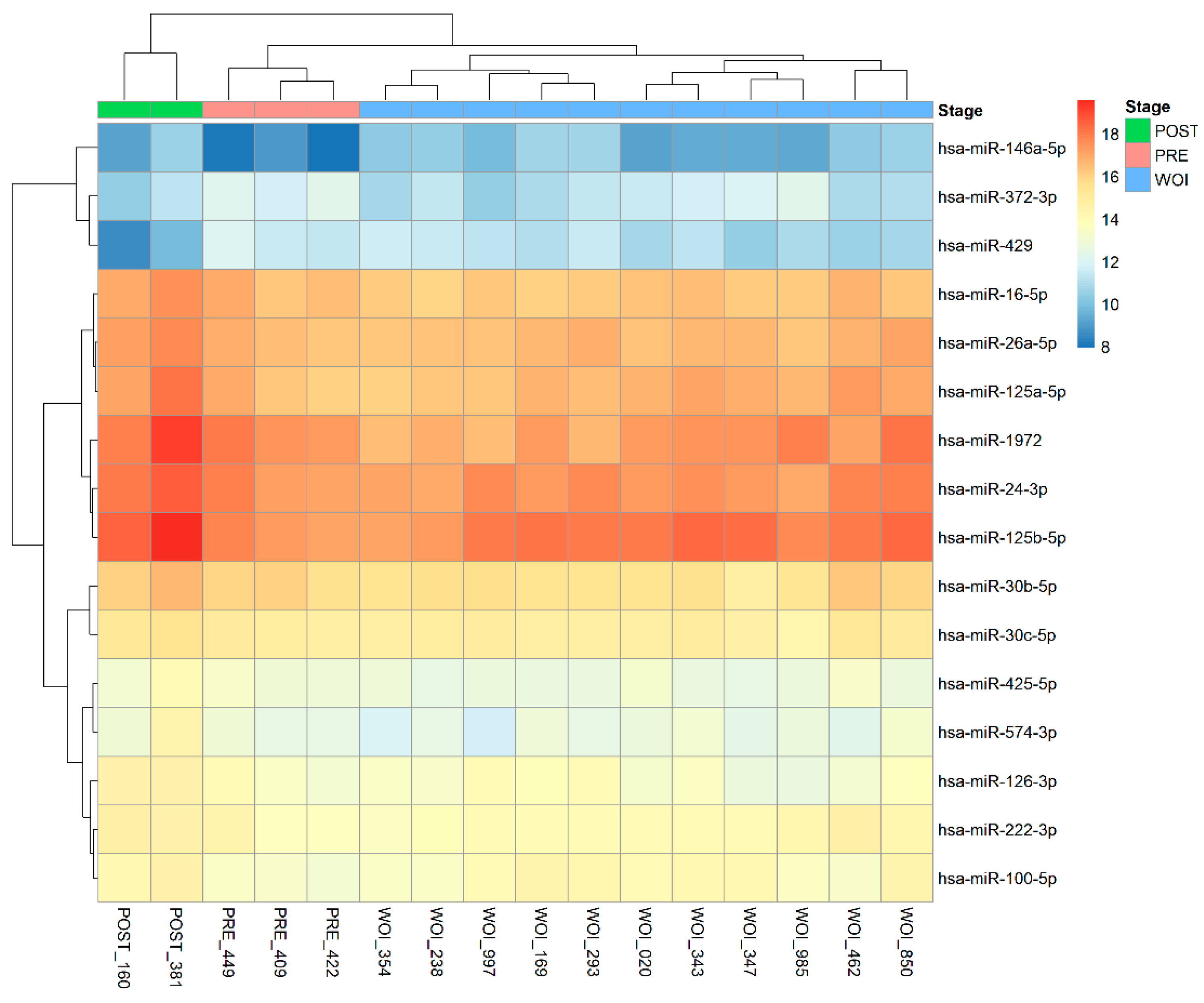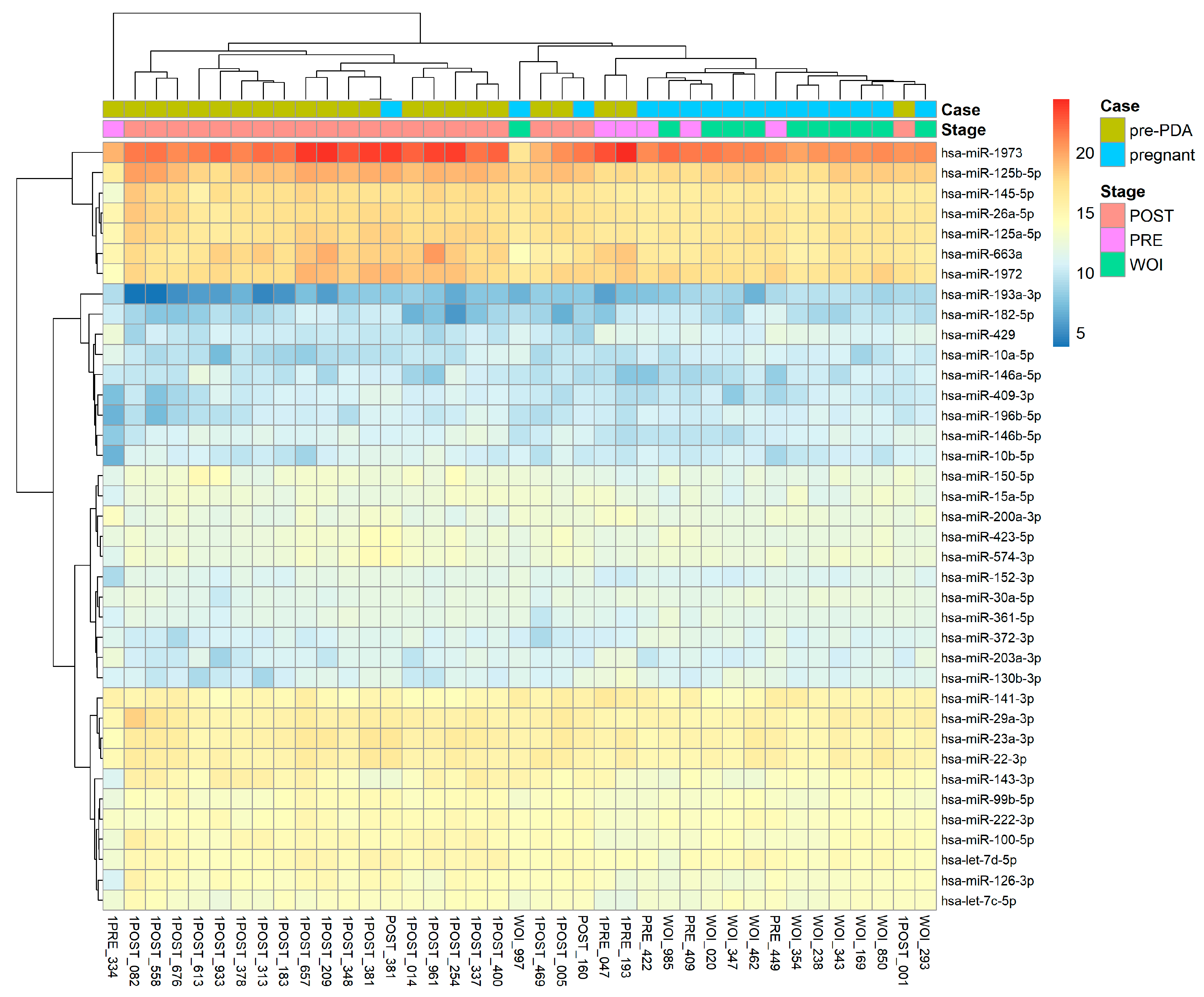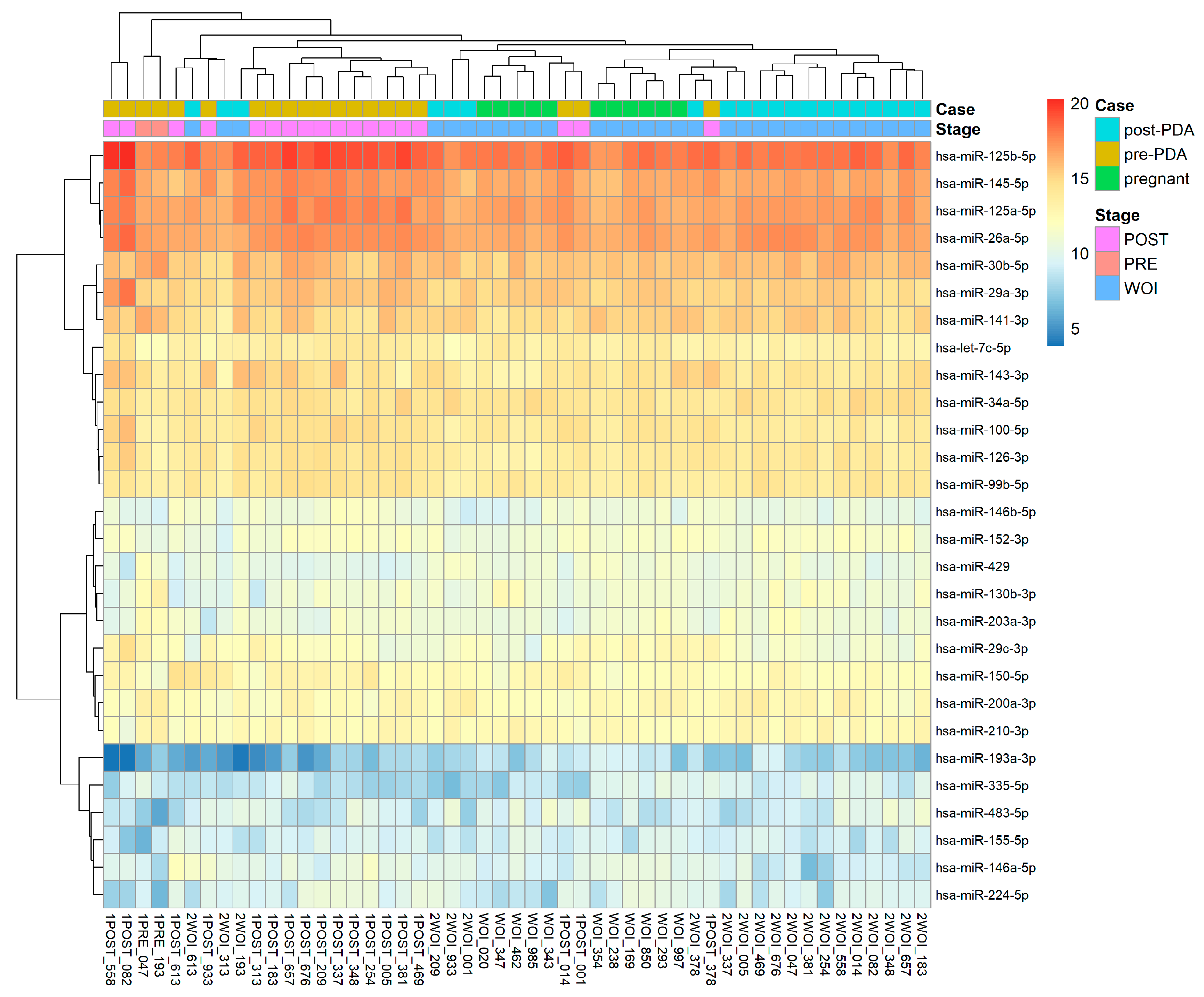1. Introduction
Progesterone (P4) plays a vital role in embryo transfer and sustaining pregnancy over the IVF process. Out-of-range serum progesterone in the late follicular phase of in vitro fertilization (IVF) cycles could detrimentally affect pregnancy outcomes, as it links directly to endometrial receptivity [
1,
2,
3].
Despite the serum progesterone level being widely acknowledged as the conventional method for luteal phase support (LPS) during embryo transfer cycles, there are persisting debates about when to start, which is the best route, the dosage and duration of P4, and whether serum progesterone at the cut-off point of 10 ng/mL is associated directly with frozen embryo transfer (FET) outcomes [
3,
4,
5,
6]. In addition to the established findings that abnormal luteal progesterone levels diminish the likelihood of pregnancy outcome [
1], research has also shown notable inter-personal variation in serum p4 levels that might influence reproductive outcomes, even when employing identical doses and routes of progesterone supplementation [
3]. These results highlight the significant role of progesterone during embryo transfer and advocate the critical need to find more patient-specific endometrial biomarkers than the “one size fits all” serum progesterone level to deliver personalized dosage control over FET processes [
3,
5,
7].
To date, more than 2500 microRNAs (miRNAs) have been discovered in the human genome. They play integral roles in diverse biological processes, including gametogenesis, embryogenesis, and the quality assessment of sperm, oocytes, and embryos, as well as diseases such as endometriosis, endometritis, and endometrial cancer [
8,
9,
10,
11]. Unlike messenger RNAs (mRNAs), miRNAs exhibit higher resilience to endogenous ribonuclease activity. Specific miRNAs like miR-30b, miR-181, and miR-223-3p govern endometrial cyclic changes, receptive state maturation, and crucial implantation markers. Dysregulated miRNAs, such as miR-21 and miR-22, may contribute to RIF by impacting early cell processes essential for implantation [
8,
9]. The MicroRNA-based Endometrial Receptivity Analysis (MIRA) platform integrates miRNA biomarkers relevant to fertility physiological processes and endometrial receptivity, offering a 95% predictive accuracy in identifying the displaced window of implantation as a contributing factor to recurrent implantation failure [
9].
Recurrent implantation failure (RIF) remains a significant challenge in assisted reproductive techniques. Previous studies identified inadequate luteal phase support in the frozen embryo transfer (FET) cycle as one of the important causes of RIF and unsuccessful pregnancy outcomes [
1,
3,
5,
6]. Given this context, we wonder whether analyzing microRNA biomarkers from endometrium tissues could be applied to provide a more adequate luteal phase support in FET cycles. Therefore, the primary objective of this article is to investigate the alterations reflected in miRNAs due to different progesterone dosages. By analyzing miRNA profiles with MIRA, we aim to provide information that could contribute to the development of personalized dosage adjustment methods aside from monitoring serum progesterone levels and provide more individualized support during the luteal phase of FET cycles.
2. Results
From the MIRA, we can see that the miRNAs have a unique expression for the three endometrial stages (pre-receptive, receptive, post-receptive), as shown below [
Figure 1]. This was validated by successful pregnancy results and was used as a baseline value in our subsequent heat map to analyze patients’ miRNA profiles.
The 22 patients included in this study all showed a displaced WOI (either pre- or post-receptive) in the initial mock cycle through MIRA’s analysis results [
Table 1]. Specifically, two samples displayed a pre-receptive window, while the remaining 20 exhibited a post-receptive profile, implying that these patients did not receive their personalized optimal progesterone dosage and showed differing miRNA expression profiles from other patients while receiving the same progesterone dosage.
Different endometrial stages for these patients could also be reflected in their miRNA expression profiles, with post-receptive patients exhibiting similar miRNA expression that differed from the pre-receptive patient’s miRNA expression [
Figure 2].
Following subsequent dosage adjustments, the endometrial status in 20 out of the 22 cases reverted to receptive at 120 h, whereas No.3 and No.8 still showed a displaced window of implantation [
Table 2]. This result implied that 91% of the patients had a correct personalized dosage adjustment. Among the unsuccessful cases, two patients transitioned from post-receptive to pre-receptive windows after the dosage adjustment.
As we were not certain whether the two patients who still presented a divergent window of implantation had no other individual physiological factors or progesterone sensitivity that might cause the persistence, we did not include them in our conclusive analysis in [
Figure 3]. However, for the remaining 20 patients, discernible shifts in their miRNA expression profiles toward the stages of the WOI following dosage modification are evident in the heatmap [
Figure 3]. The directional transition, progressing from the left to right side of the heatmap, suggests the efficacy of successful progesterone dosage adjustments (PDA) in achieving a more favorable alignment with the receptive stage.
3. Discussion
Previously, optimal progesterone dosage during the luteal phase support was determined based on monitoring serum P4 levels. However, due to physiological differences in each individual, there is no consensus about a standard protocol for progesterone dosages and serum thresholds at 10 ng/mL that benefit reproduction outcomes [
2,
3,
4,
6].
In this study, patients who received the same progesterone dosage exhibited different miRNA expression profiles that correlated to different receptivity outcomes in the first mock cycle. This result implied that miRNA profiles could be utilized as unique biomarkers for reflecting individual endometrial status among patients even when they were administered the same dosage treatment. This personalized feature could potentially address the challenge of the inter-personal variation of serum progesterone levels seen from previous research [
1,
3,
6] to guide decisions of progesterone dosage adjustments more accurately.
While nearly 91% of patients exhibiting a displaced window of implantation successfully restored their endometrial stages to the standard 120 h post progesterone dosage adjustments, it is noted that two individuals showed endometrial stage alteration indicating different progesterone tolerance compared to the other patients, which could be adjusted accordingly to find the adequate progesterone dosage for embryo transfer.
We investigated the changes in miRNA profiles among patients who received progesterone dosage adjustments, and they exhibited a shift in biomarker profiles as expected, which demonstrated a successful cohesion of their corresponding miRNA profiles toward the receptive stages based on MIRA. As miRNAs can influence and reflect the endometrium’s changes from the biological level, monitoring the optimal progesterone dosage in IVF patients could be tracked by utilizing miRNA biomarkers.
There is a growing amount of research emphasizing the potential role of miRNAs in personalized medicine within reproductive pathology and their evolving avenues for diagnostics and prognostics in fertility-related conditions such as gynecological cancer, polycystic ovary syndrome, and altered steroid hormone biology [
12,
13]. The result of this research could contribute to this evolving field by shedding light on a novel approach and insights into the utilization of miRNA in female health and assisted reproduction treatment by harnessing the power of the genetic encoding messenger to enhance patient-specific treatments.
Since variation in the endometrium’s status and serum progesterone in each individual was evident both in our study and previous findings [
1,
3,
6], solely relying on monitoring the serum P4 level might not provide accurate and comprehensive guidance for determining progesterone dosages. This study underscores the significant potential of utilizing miRNA biomarkers to monitor patients’ endometrium status and make informed decisions regarding the optimal progesterone dosage for each individual. miRNAs could potentially serve as more accurate biomarkers compared to serum progesterone alone, offering a promising alternative for predicting the adequate dosage of progesterone in the luteal phase support for frozen embryo transfer cycles. Such innovative findings could help to revolutionize traditional practices in determining the optimal progesterone dosage and addressing the clinical challenge of delivering personalized IVF treatment based on individual conditions.
4. Materials and Methods
This study is a retrospective study that utilized MIRA, an miRNA-based endometrial receptivity test that analyzes close to 100 biomarkers, to look at the specific miRNA expression profile changes in IVF patients undergoing hormone replacement therapy (HRT) under a progesterone dosage adjustment (PDA) protocol for personalized embryo transfer (pET). Approval of this study was obtained from the Joint Institutional Review Board (JIRB, No.19-S-011-1) in 2019.
In the first mock cycle, 22 patients’ receptivity status and miRNA expression profiles were determined through MIRA by taking an endometrial tissue biopsy at 120 ± 4 h after progesterone administration vaginally (Utrogestan, 800 mg per day). Subsequent adjustments to the progesterone dosage were implemented if a pre- or post-receptive (indication of excessive or insufficient progesterone dosage) was identified. Among patients with a baseline pre-receptive window, the progesterone dosage was decreased from 800 mg to 600 mg vaginally in order to delay their WOI back to normal 120 h after progesterone administration. Similarly, for patients identified with a post-receptive window, their progesterone was increased from 800 mg to 1000 mg vaginally to speed up their WOI. In the second mock cycle, the cycle after dosage adjustment, a second endometrial tissue biopsy using MIRA was performed at P + 5 to assess whether the change in progesterone dosage altered the displaced WOI back to receptive at 120 h (indication of a proper progesterone dosage).
For data analysis, Analysis of Variance (ANOVA) was adopted in this study to understand the statistical changes in the miRNA profiles and the corresponding endometrial stages.
5. Conclusions
From this research we can conclude that different progesterone dosages result in differences in both the endometrial stages and miRNA profiles across individuals undergoing frozen embryo transfer cycles. Given the intrinsic relationship between progesterone dosage and its corresponding plasma concentration, alterations in dosage inherently impact the other two biological factors. This potentially implies a novel approach that could deliver personalized progesterone dosage adjustments for optimal endometrial receptivity stages. Nevertheless, how the endometrial status and its associated miRNA profile could be influenced by dosage adjustment varies between individuals, highlighting the benefit of utilizing miRNA biomarkers to reflect the unique status of each individual.
In conclusion, we found that different dosages of progesterone in luteal phase support affected the different expression of endometrial receptivity-related miRNA and could be adjusted to the optimal progesterone dosages. Personalized dosage adjustments (PDA) based on miRNA biomarker profiles might imply unique luteal phase support to identify the ideal dosage of progesterone for frozen embryo transfer cycles. Moreover, microRNAs (miRNAs) have the potential to monitor progesterone levels as a more reliable and accurate tool for guiding patient-specific progesterone dosage administration decisions. Further investigations are warranted to elucidate the precise relationship between progesterone dosages and corresponding variations in miRNA expression, providing a more comprehensive understanding for guiding dosage adjustments as a large proportion of this study presented a post-receptive window over the first mock cycle.
Author Contributions
Conceptualization, W.-J.Y. and F.L.; methodology, W.-J.Y. and F.L.; software, J.-J.H.; validation, W.-J.Y. and F.L.; formal analysis, J.-J.H.; investigation, W.-J.Y. and F.L.; resources, W.-J.Y. and F.L.; data curation, J.-J.H.; writing—original draft preparation, C.-Y.W.; writing—review and editing, T.W.; visualization, J.-J.H. and C.-Y.W.; supervision, W.-J.Y.; project administration, W.-J.Y., F.L., T.W., P.E.Y. and J.Y.-J.H.; funding acquisition, W.-J.Y. and F.L. All authors have read and agreed to the published version of the manuscript.
Funding
This research received no external funding.
Institutional Review Board Statement
The study was conducted in accordance with the Declaration of Helsinki and approved by the Joint Institutional Review Board (JIRB No.19-S-011-1) in 2019.
Informed Consent Statement
Informed consent was obtained from all subjects involved in the study.
Data Availability Statement
Data are contained within the article.
Conflicts of Interest
Authors Cai-Yun Wang, Jun-Jie Hong, Tiffany Wang, and Pok Eric Yang were employed by the company Inti Labs in Hsinchu City, Taiwan. The remaining authors declare that the research was conducted in the absence of any commercial or financial relationships that could be construed as a potential conflict of interest.
References
- Thomsen, L.H.; Kesmodel, U.S.; Erb, K.; Bungum, L.; Pedersen, D.; Hauge, B.; Elbæk, H.O.; Povlsen, B.B.; Andersen, C.Y.; Humaidan, P. The impact of luteal serum progesterone levels on live birth rates-a prospective study of 602 IVF/ICSI cycles. Hum. Reprod. 2018, 33, 1506–1516. [Google Scholar] [CrossRef] [PubMed]
- Orvieto, R.; Venetis, C.A.; Fatemi, H.M.; D’Hooghe, T.; Fischer, R.; Koloda, Y.; Horton, M.; Esteves, S.C.; Sunkara, S.K.; Alviggi, C. Optimising Follicular Development, Pituitary Suppression, Triggering and Luteal Phase Support During Assisted Reproductive Technology: A Delphi Consensus. Front. Endocrinol. 2021, 12, 675670. [Google Scholar] [CrossRef] [PubMed]
- Melo, P.; Chung, Y.; Pickering, O.; Price, M.J.; Fishel, S.; Khairy, M.; Kingsland, C.; Lowe, P.; Petsas, G.; Rajkhowa, M.; et al. Serum luteal phase progesterone in women undergoing frozen embryo transfer in assisted conception: A systematic review and meta-analysis. Fertil. Steril. 2021, 116, 1534–1556. [Google Scholar] [CrossRef] [PubMed]
- Labarta, E.; Rodríguez, C. Progesterone use in assisted reproductive technology. Best Pract. Res. Clin. Obstet. Gynaecol. 2020, 69, 74–84. [Google Scholar] [CrossRef] [PubMed]
- Di Guardo, F.; Midassi, H.; Racca, A.; Tournaye, H.; De Vos, M.; Blockeel, C. Luteal Phase Support in IVF: Comparison Between Evidence-Based Medicine and Real-Life Practices. Front. Endocrinol. 2020, 11, 500. [Google Scholar] [CrossRef] [PubMed]
- Volovsky, M.; Pakes, C.; Rozen, G.; Polyakov, A. Do serum progesterone levels on day of embryo transfer influence pregnancy outcomes in artificial frozen-thaw cycles? J. Assist. Reprod. Genet. 2020, 37, 1129–1135. [Google Scholar] [CrossRef] [PubMed]
- Mumusoglu, S.; Polat, M.; Ozbek, I.Y.; Bozdag, G.; Papanikolaou, E.G.; Esteves, S.C.; Humaidan, P.; Yarali, H. Preparation of the Endometrium for Frozen Embryo Transfer: A Systematic Review. Front. Endocrinol. 2021, 12, 688237. [Google Scholar] [CrossRef] [PubMed]
- Chen, M.J.; Hsu, A.; Lin, P.Y.; Chen, Y.L.; Wu, K.W.; Chen, K.C.; Wang, T.; Yi, Y.C.; Kung, H.F.; Chang, J.C.; et al. Development of a Predictive Model for Optimization of Embryo Transfer Timing Using Blood-Based microRNA Expression Profile. Int. J. Mol. Sci. 2023, 25, 76. [Google Scholar] [CrossRef] [PubMed]
- Chen, C.H.; Lu, F.; Yang, W.J.; Yang, P.E.; Chen, W.M.; Kang, S.T.; Huang, Y.S.; Kao, Y.C.; Feng, C.T.; Chang, P.C.; et al. A novel platform for discovery of differentially expressed microRNAs in patients with repeated implantation failure. Fertil. Steril. 2021, 116, 181–188. [Google Scholar] [CrossRef]
- Maziotis, E.; Kalampokas, T.; Giannelou, P.; Grigoriadis, S.; Rapani, A.; Anifantakis, M.; Kotsifaki, A.; Pantou, A.; Triantafyllidou, O.; Tzanakaki, D.; et al. Commercially Available Molecular Approaches to Evaluate Endometrial Receptivity: A Systematic Review and Critical Analysis of the Literature. Diagnostics 2022, 12, 2611. [Google Scholar] [CrossRef] [PubMed]
- Kolanska, K.; Bendifallah, S.; Canlorbe, G.; Mekinian, A.; Touboul, C.; Aractingi, S.; Chabbert-Buffet, N.; Daraï, E. Role of miRNAs in Normal Endometrium and in Endometrial Disorders: Comprehensive Review. J. Clin. Med. 2021, 10, 3457. [Google Scholar] [CrossRef] [PubMed]
- Zhang, R.; Wesevich, V.; Chen, Z.; Zhang, D.; Kallen, A.N. Emerging roles for noncoding RNAs in female sex steroids and reproductive disease. Mol. Cell. Endocrinol. 2020, 518, 110875. [Google Scholar] [CrossRef] [PubMed]
- Cavaliere, A.F.; Perelli, F.; Zaami, S.; Piergentili, R.; Mattei, A.; Vizzielli, G.; Scambia, G.; Straface, G.; Restaino, S.; Signore, F. Towards Personalized Medicine: Non-Coding RNAs and Endometrial Cancer. Healthcare 2021, 9, 965. [Google Scholar] [CrossRef]
| Disclaimer/Publisher’s Note: The statements, opinions and data contained in all publications are solely those of the individual author(s) and contributor(s) and not of MDPI and/or the editor(s). MDPI and/or the editor(s) disclaim responsibility for any injury to people or property resulting from any ideas, methods, instructions or products referred to in the content. |
© 2024 by the authors. Licensee MDPI, Basel, Switzerland. This article is an open access article distributed under the terms and conditions of the Creative Commons Attribution (CC BY) license (https://creativecommons.org/licenses/by/4.0/).









